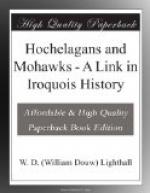of them, who, when he returned next year, called the
place where they had been taken
Honguedo, and
said that the north shore, above Anticosti Island,
was the commencement of inhabited country which led
to
Canada (the Quebec region), Hochelaga, (Montreal)
and the country of
Saguenay, far to the west
“whence came the red copper” (of which
axes have since been found in the debris of Hochelaga,
and which, in fact, came from Lake Superior), and
that no man they ever heard of had ever been to the
end of the great river of fresh water above. Here
we have the first indication of the racial situation
of the Hochelagans. At the mouth of the Saguenay
River—so called because it was one of the
routes to the Sagnenay of the Algonquins, west of the
Upper Ottawa—he found four fishing canoes
from Canada. Plenty of fishing was prosecuted
from this point upwards. In “the Province
of Canada,” he proceeds, “there are several
peoples in unwalled villages.” At the Isle
of Orleans, just below Quebec, the principal peace
chief, or, Agouhanna of “Canada,” Donnaconna,
came to them with 12 canoes from the town (ville)
of Stadacona, or Stadacone, which was surrounded by
tilled land on the heights. Twenty-five canoes
from Stadacona afterwards visited them; and later
Donnaconna brought on board “10 or 12 other of
the greatest chiefs” with more than 500 persons,
men, women and children, some doubtless from the neighbouring
settlements. If the same 200 persons as in the
previous year were absent fishing at Gaspe, and others
in other spots, these figures argue a considerable
population.
Below Stadacona, were four “peoples and settlements”:
Ajoaste, Starnatam, Tailla (on a mountain)
and Satadin or Stadin. Above Stadacona
were Tekenouday (on a mountain) and Hochelay
(Achelacy or Hagouchouda)[3] which was
in open country. Further up were Hochelaga
and some settlements on the island of Montreal, and
various other places unobserved by Cartier, belonging
to the same race; who according to a later statement
of the remnant of them, confirmed by archaeology,
had several “towns” on the island of Montreal
and inhabited “all the hills to the south
and east."[4] The hills to be seen from Mount
Royal to the south are the northern slopes of the Adirondacks;
while to the east are the lone volcanic eminences in
the plain, Montarville, Beloeil, Rougemont, Johnson,
Yamaska, Shefford, Orford and the Green Mountains.
All these hills deserve search for Huron-Iroquois
town-sites. The general sense of this paragraph
includes an implication also of settlements towards
and on Lake Champlain, that is to say, when taken
in connection with the landscape. (My own dwelling
overlooks this landscape.) At the same time let me
say that perhaps due inquiries might locate some of
the sites of Ajoaste and the other villages in the
Quebec district. In Cartier’s third voyage
he refers obscurely, in treating of Montreal, to “the




